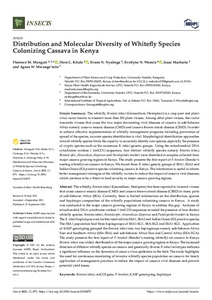| dc.contributor.author | Munguti, F. |
| dc.contributor.author | Kilalo, D. |
| dc.contributor.author | Nyaboga, E. |
| dc.contributor.author | Wosula, E.N. |
| dc.contributor.author | Macharia, I. |
| dc.contributor.author | Mwango'mbe, A. |
| dc.date.accessioned | 2022-02-01T08:31:23Z |
| dc.date.available | 2022-02-01T08:31:23Z |
| dc.date.issued | 2021 |
| dc.identifier.citation | Munguti, F., Kilalo, D., Nyaboga, E., Wosula, E.N., Macharia, I. & Mwango’mbe, A. (2021). Distribution and molecular diversity of whitefly species colonizing cassava in Kenya. Insects, 12(10):875, 1-16. |
| dc.identifier.issn | 2075-4450 |
| dc.identifier.uri | https://hdl.handle.net/20.500.12478/7330 |
| dc.description.abstract | The whitefly, Bemisia tabaci (Gennadium, Hemiptera) has been reported to transmit viruses that cause cassava mosaic disease (CMD) and cassava brown streak disease (CBSD) in many parts of sub-Saharan Africa (SSA). Currently, there is limited information on the distribution, species and haplotype composition of the whitefly populations colonizing cassava in Kenya. A study was conducted in the major cassava growing regions of Kenya to address this gap. Analyses of mitochondrial DNA cytochrome oxidase 1 (mtCO1) sequences revealed the presence of four distinct whitefly species: Bemisia tabaci, Bemisia afer, Aleurodicus dispersus and Paraleyrodes bondari in Kenya. The B. tabaci haplotypes were further resolved into SSA1, SSA2 and Indian Ocean (IO) putative species. The SSA1 population had three haplogroups of SSA1-SG1, SSA-SG2 and SSA1-SG3. Application of KASP genotyping grouped the Bemisia tabaci into two haplogroups namely sub-Saharan Africa East and Southern Africa (SSA-ESA) and sub-Saharan Africa East and Central Africa (SSA-ECA). The study presents the first report of P. bondari (Bondar’s nesting whitefly) on cassava in Kenya. Bemisia tabaci was widely distributed in all the major cassava growing regions in Kenya. The increased detection of different whitefly species on cassava and genetically diverse B. tabaci mitotypes indicates a significant influence on the dynamics of cassava virus epidemics in the field. The study highlights the need for continuous monitoring of invasive whitefly species population on cassava for timely application of management practices to reduce the impact of cassava viral diseases and prevent potential yield losses. |
| dc.description.sponsorship | Regional Universities Forum for Capacity Building in Agriculture |
| dc.format.extent | 1-16 |
| dc.language.iso | en |
| dc.subject | Bemisia Tabaci |
| dc.subject | Genes |
| dc.subject | Paraleyrodes |
| dc.subject | Genotypes |
| dc.subject | Haplotypes |
| dc.subject | East Africa |
| dc.subject | Kenya |
| dc.title | Distribution and molecular diversity of whitefly species colonizing cassava in Kenya |
| dc.type | Journal Article |
| cg.contributor.crp | Roots, Tubers and Bananas |
| cg.contributor.affiliation | University Nairobi |
| cg.contributor.affiliation | Kenya Plant Health Inspectorate Services |
| cg.contributor.affiliation | International Institute of Tropical Agriculture |
| cg.coverage.region | Africa |
| cg.coverage.region | East Africa |
| cg.coverage.country | Kenya |
| cg.coverage.hub | Eastern Africa Hub |
| cg.researchtheme | Biotech and Plant Breeding |
| cg.identifier.bibtexciteid | MUNGUTI:2021 |
| cg.isijournal | ISI Journal |
| cg.authorship.types | CGIAR and developing country institute |
| cg.iitasubject | Agronomy |
| cg.iitasubject | Cassava |
| cg.iitasubject | Climate Change |
| cg.iitasubject | Food Security |
| cg.iitasubject | Plant Breeding |
| cg.iitasubject | Plant Health |
| cg.iitasubject | Plant Production |
| cg.journal | Insects |
| cg.notes | Open Access Journal; Published online: 27 Sep 2021 |
| cg.accessibilitystatus | Open Access |
| cg.reviewstatus | Peer Review |
| cg.usagerightslicense | Creative Commons Attribution 4.0 (CC BY 0.0) |
| cg.targetaudience | Scientists |
| cg.identifier.doi | https://dx.doi.org/10.3390/insects12100875 |
| cg.iitaauthor.identifier | EVERLYNE WOSULA: 0000-0001-5693-0889 |
| cg.futureupdate.required | No |
| cg.identifier.issue | 10:875 |
| cg.identifier.volume | 12 |

